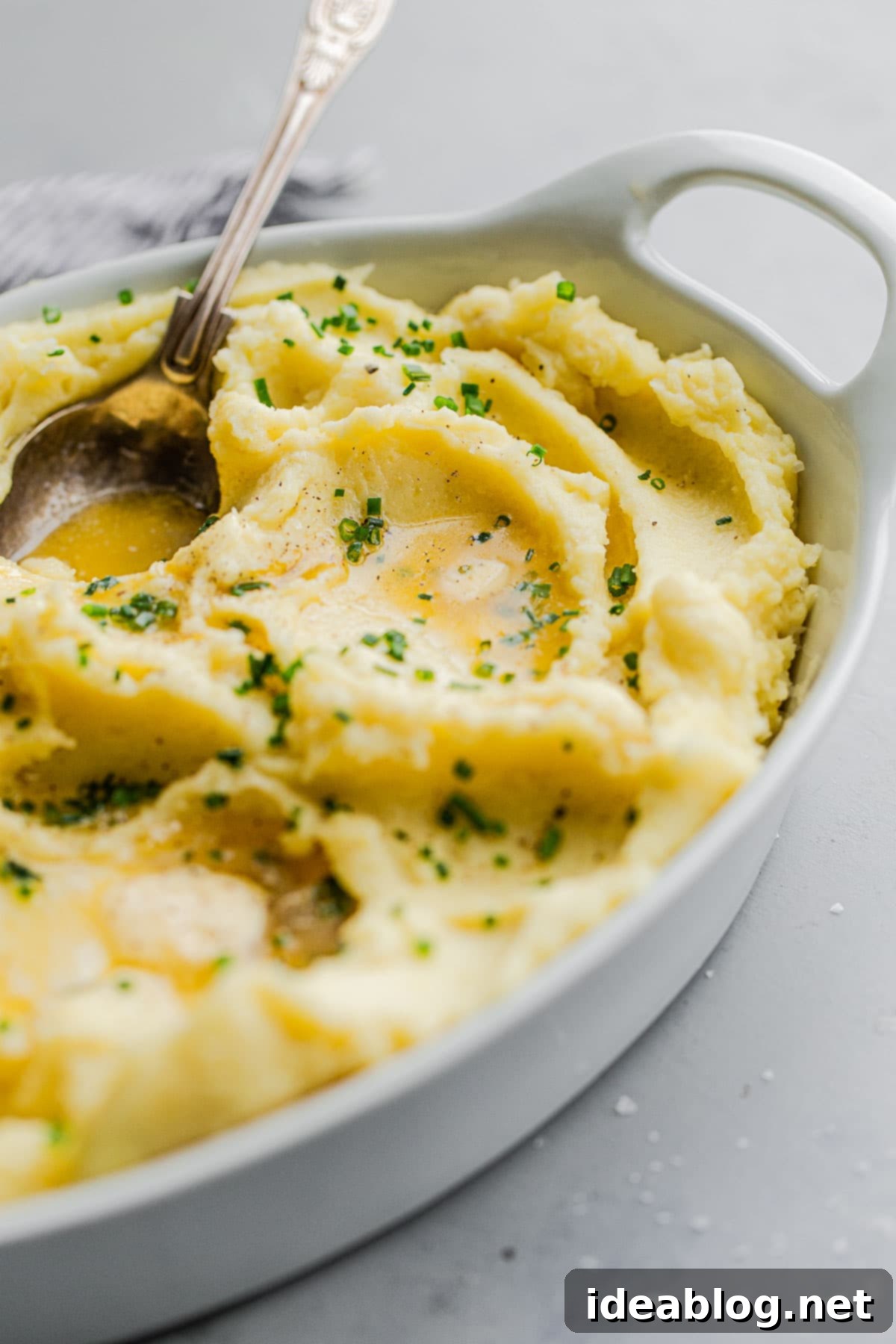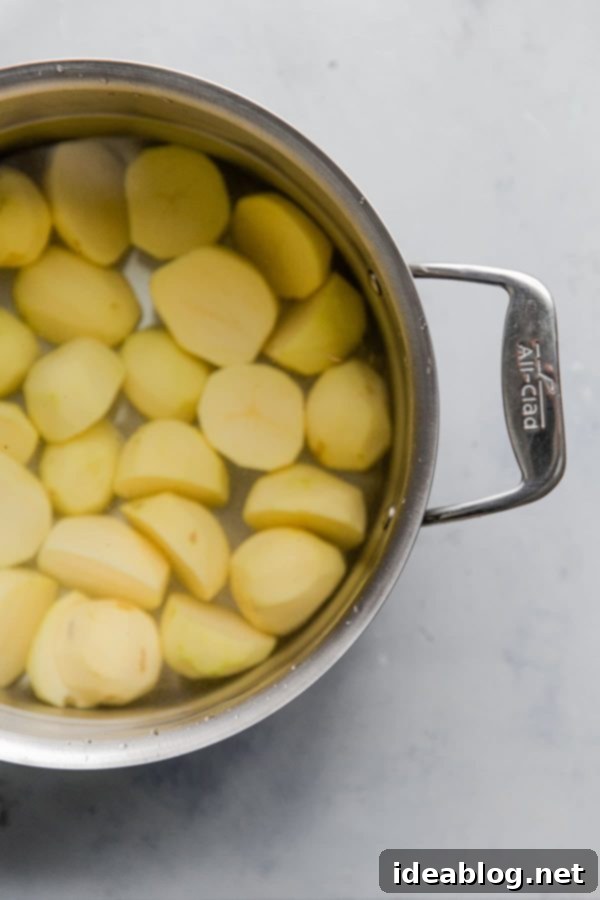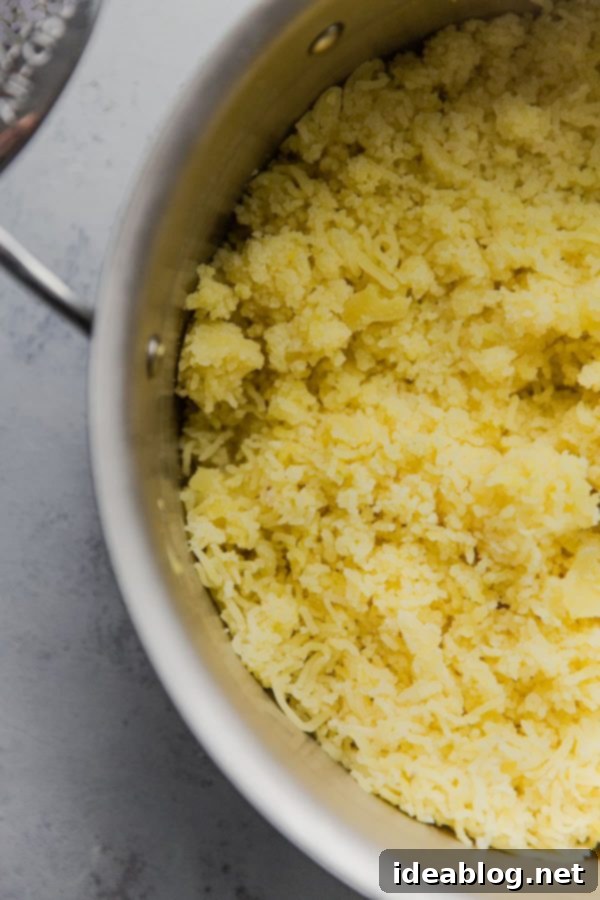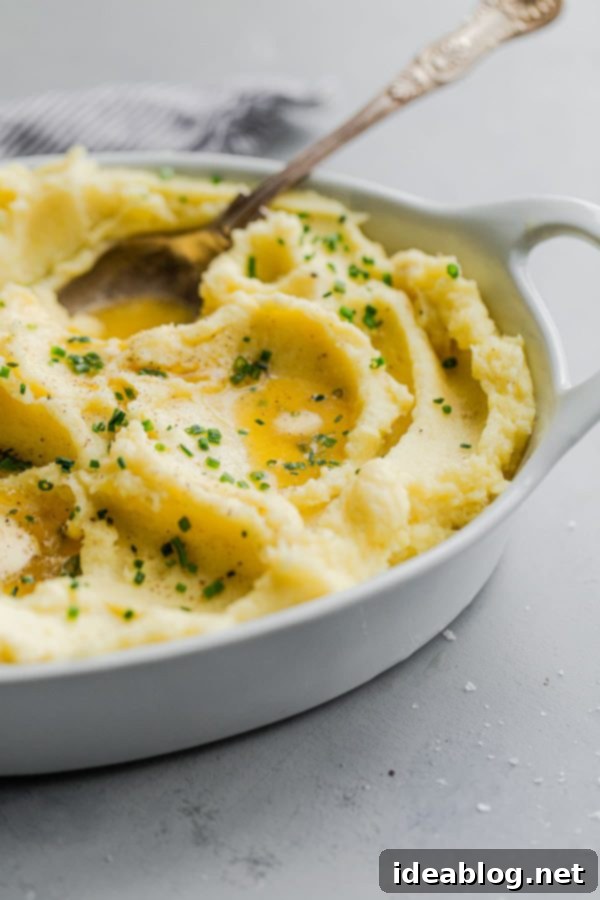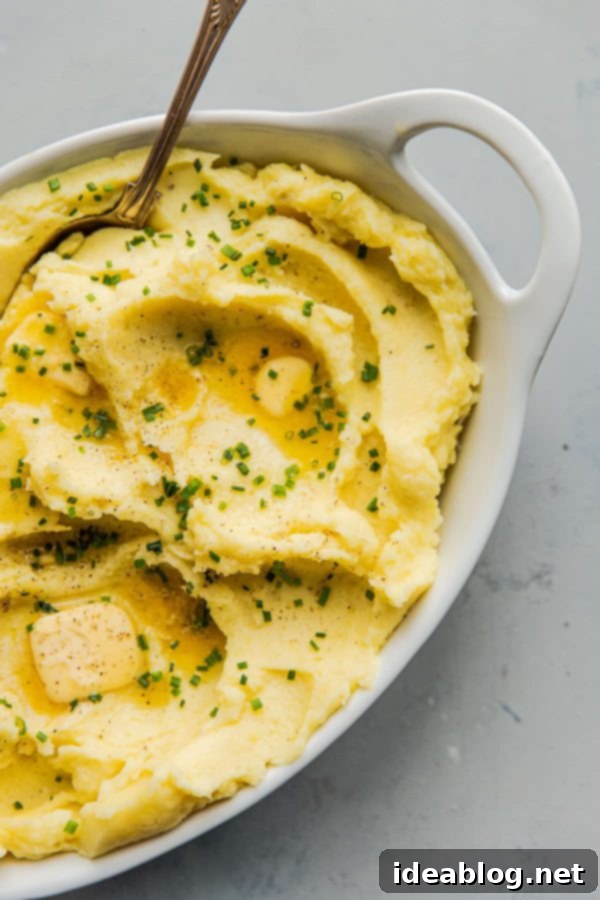The Ultimate Guide to Ultra-Creamy Yukon Gold Mashed Potatoes for Any Occasion
Prepare to elevate your side dish game with these incredibly rich and creamy Yukon Gold Mashed Potatoes. Crafted with a luxurious blend of heavy cream and unsalted butter, then beautifully garnished with fresh chives, this recipe promises a truly unforgettable culinary experience. Whether you’re planning an elaborate holiday feast or simply seeking the perfect accompaniment for a comforting weeknight meal, these mashed potatoes are guaranteed to impress. Dive into our detailed instructions below, including comprehensive tips for making ahead and reheating, ensuring your potatoes are always perfect.
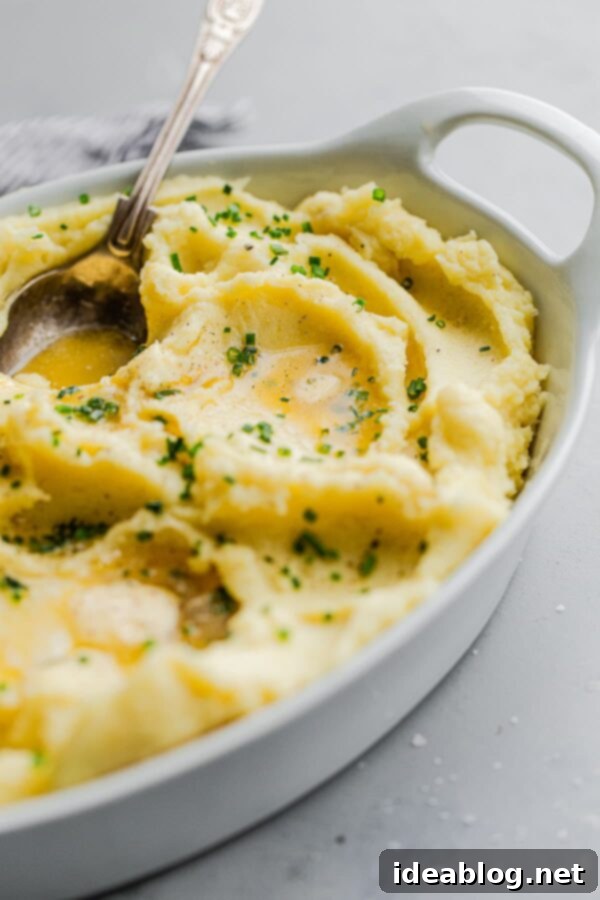
When the holiday season rolls around, or even when I’m just craving a classic, comforting side, my go-to is always mashed potatoes. But not just any mashed potatoes – these Yukon Gold Mashed Potatoes are a staple. They are the epitome of creamy, buttery perfection, yet surprisingly simple to prepare. This recipe has consistently earned its spot on our Thanksgiving table for years, often alongside delightful pairings like Roasted Brussels Sprouts and Butternut Squash, proving its enduring appeal.
The beauty of this mashed potato recipe lies in its incredible versatility. It truly does pair well with *everything*. From succulent holiday roasts and slow-braised meats to hearty stews and any dish blessed with a rich, thick sauce or savory gravy, these potatoes act as the ultimate culinary canvas, soaking up flavors and adding a luxurious texture that completes the meal. Their smooth, velvety consistency makes them the ideal foundation for countless culinary creations, transforming any ordinary dinner into a gourmet experience.
If you’re on the hunt for a tried-and-true mashed potato recipe to add to your holiday cooking arsenal, or simply to become a new family favorite, look no further. This recipe is designed to deliver consistent, delicious results every time. It’s a foundational side dish that embodies comfort and elegance, perfect for both novice cooks and seasoned chefs alike.
Beyond the core recipe, I’ve compiled my best mashed potato tricks and tips to ensure your success. This includes crucial advice for achieving that perfect creamy texture, as well as detailed reheating instructions that will make hosting and entertaining during the busy holiday season as stress-free and enjoyable as possible. Imagine preparing this beloved side dish in advance, freeing up valuable time to focus on other elements of your meal or simply to relax and enjoy the company of your guests.
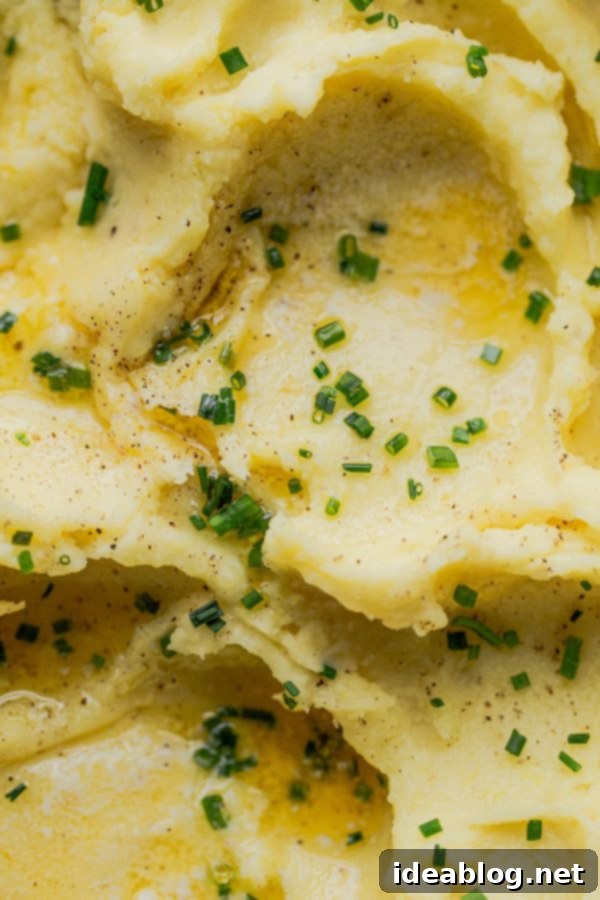
Understanding Your Yield: How Many Potatoes Per Person?
This recipe is designed to yield approximately 6 to 8 generous servings, making it perfect for family dinners or smaller gatherings. When planning for a larger crowd, a good rule of thumb is to allot roughly a 1/2-pound (or just slightly under a 1/2-pound) of potatoes per person. This ensures everyone gets a satisfying portion of this beloved side dish without excessive leftovers, though, honestly, who minds leftover mashed potatoes?
The Simple, Yet Essential, Ingredients for Perfect Mashed Potatoes
You’ll be delighted to find that you only need a handful of basic, high-quality ingredients to create these incredibly flavorful mashed potatoes. The secret truly lies in the choice of potato and the richness of the dairy.
- Yukon Gold Potatoes: The star of our show, chosen for their naturally buttery flavor and creamy texture.
- Heavy Cream: Essential for imparting that luscious, velvety consistency and rich mouthfeel.
- Unsalted Butter: The foundation of all good mashed potatoes. Using unsalted butter allows you to control the overall saltiness of the dish. For an extra fantastic depth of flavor, consider making your own Cultured Butter.
- Kosher Salt and Freshly Ground Black Pepper: Key for seasoning to taste. Kosher salt provides a clean, mild flavor and excellent texture.
- Fresh Chives (Optional Garnish): A delightful addition for a touch of freshness, color, and a mild oniony zest that brightens the dish.
Flavor Variations and Personal Touches
While classic perfection is our goal, these mashed potatoes are incredibly adaptable. If you’re a fan of tangy mashed potatoes, consider stirring in a touch of creme fraiche, sour cream, or buttermilk at the end. These additions introduce a delightful acidity that balances the richness of the cream and butter, offering a sophisticated twist. Experiment with small amounts and taste as you go to achieve your preferred level of tanginess.
Recipe Variation: Garlic Mashed Potatoes: For garlic lovers, there are several wonderful ways to infuse this recipe with aromatic garlic flavor. You can add 1-2 peeled garlic cloves directly to the pot with the potatoes while they boil. Alternatively, for a more intense and mellow garlic flavor, stir in a spoonful of velvety garlic confit or a few cloves of roasted garlic once the potatoes are mashed. For an elevated garnish that adds both flavor and crunch, consider topping your finished potatoes with homemade garlic chips. Feel free to make them entirely your own!
Yukon Gold Potatoes vs. Russet Potatoes: A Deeper Dive
When it comes to the perfect mashed potato, the choice of potato variety is paramount, and Yukon Gold potatoes (a type of yellow potato) are, in my humble opinion, the undisputed champions. They possess a medium starch level, which is ideal for mashing, as it prevents them from becoming gluey while still allowing for that desirable creamy texture.
Beyond their texture, Yukon Golds boast a beautiful, naturally golden-yellow hue that makes for an aesthetically pleasing dish, and their flavor profile is truly unparalleled. They have an inherent buttery richness that surpasses that of classic Russet potatoes. While Russets are often cheaper and cook faster, their drier, floury texture and milder flavor simply can’t compare to the luscious results achieved with Yukon Golds.
It’s true that Yukon Gold potatoes might be a little more expensive and may require a slightly longer cook time due to their denser flesh, but the superior flavor and texture they deliver are well worth the minor investment of time and money. While I personally prefer to peel them for the smoothest possible mash, Yukon Gold potatoes can also be mashed with their thin skins on, offering an additional layer of earthy flavor and a delightful textural contrast for those who enjoy a more rustic preparation.
If you’ve spent years preparing your mashed potatoes exclusively with Russet potatoes, I wholeheartedly encourage you to give Yukon Golds a try. I have a strong feeling that once you experience their creamy texture and rich, buttery flavor, you won’t want to go back to any other variety for your mashed potato needs. It’s a game-changer for this beloved comfort food.
How to Make Perfectly Creamy Yukon Gold Mashed Potatoes: Step-by-Step
Achieving perfectly smooth and creamy mashed potatoes is simpler than you might think. Follow these steps for an irresistible result:
- Prepare the Potatoes: Begin by thoroughly peeling the Yukon Gold potatoes. Once peeled, cut them into uniform quarters. The goal is to keep the potato pieces as close in size as possible to ensure even cooking. If you have particularly large Yukon Gold potatoes, quartering them will significantly speed up the cooking process. Smaller potatoes might only need to be halved. Transfer your prepared potatoes to a large pot, then cover them generously with cold, salted water. Starting with cold water allows the potatoes to cook evenly as the water gradually heats up, preventing the outsides from becoming mushy while the centers remain firm.
- Cook to Perfection: Cover the pot with a lid and bring the water to a full boil over high heat. Once boiling, reduce the heat to maintain a steady, gentle simmer. Continue simmering the potatoes until they are fork-tender and can be easily pierced with a knife or fork. A good test is if they slip off the knife without resistance. If you feel any firmness, continue cooking and check again in a few minutes. Avoid overcooking, as this can lead to waterlogged potatoes.
- Warm the Dairy: While the potatoes are cooking, combine the heavy cream and unsalted butter in a small saucepan. Place this over very low heat, gently warming the mixture until the butter has fully melted and the cream is warm to the touch. The purpose of warming the cream and butter is crucial: it helps the potatoes absorb them more readily, resulting in a silkier, smoother texture, and ensures your mashed potatoes stay deliciously hot for serving.
- Mash the Potatoes: Once the potatoes are perfectly tender, carefully drain them. You can simultaneously warm your serving dish by placing it directly underneath your colander – allowing the hot cooking water to heat it thoroughly. Just remember to dry it well before using! If you’re using a potato ricer (highly recommended for the best texture), rice the drained potatoes in batches directly into the empty, warm cooking pot. If you’re using a traditional potato masher, transfer the drained potatoes to the pot, add the warm cream and butter mixture immediately, and begin mashing.
- Combine and Season: Pour the warm cream and butter mixture over the riced or mashed potatoes. If you’re incorporating creme fraiche or sour cream for a tangy note, add it now. Add a generous pinch of kosher salt and freshly ground black pepper. Using a large spoon or spatula, gently fold the ingredients together. The key here is to mix gently and avoid overmixing, as this can activate the starch in the potatoes and result in a gluey, undesirable texture. Taste and adjust the seasoning with more salt and pepper as needed. If you desire a looser, creamier consistency, feel free to add an additional splash of warm heavy cream or whole milk.
- Serve Immediately: Transfer the finished mashed potatoes to your warmed serving dish. Use the back of a large spoon to smooth the top and create inviting swoops or peaks. For a final flourish, dot the top with a few thin slices of unsalted butter, allowing them to melt into the hot potatoes, and garnish generously with finely chopped fresh chives. Serve these ultra-creamy Yukon Gold mashed potatoes immediately to enjoy their optimal texture and warmth.
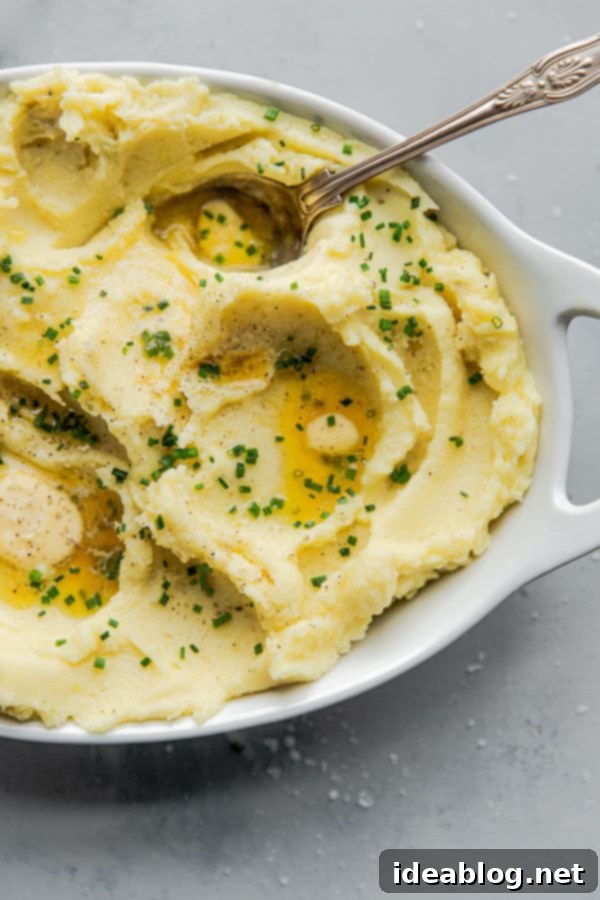
The Magic of a Potato Ricer: Achieving Unbeatable Fluffiness
A potato ricer is genuinely one of my most cherished kitchen tools, especially when it comes to making mashed potatoes. This ingenious device is a game-changer for achieving exceptionally fluffy, smooth, and lump-free mashed potatoes. The beauty of a ricer lies in its ability to separate the potato starch cells without rupturing them excessively. This is a critical distinction, as over-activating the starch in potatoes is precisely what leads to that dreaded gluey, pasty texture that no one desires in their mashed potatoes.
Potato ricers work by forcing cooked potato pieces through very small, uniform holes, effectively extruding them into fine, rice-like strands. This process not only ensures a consistent, smooth texture but also keeps the individual starch cells largely intact. The result is an incredibly light, airy, and uniform mash that absorbs dairy and butter beautifully, creating a truly luxurious mouthfeel.
While you certainly don’t *need* a potato ricer to make delicious mashed potatoes (a traditional masher will work perfectly fine with careful technique), it is a fantastic investment if you frequently make mashed potatoes or other potato-based dishes. Beyond mashed potatoes, a ricer proves incredibly helpful for other preparations, such as creating the ideal consistency for homemade potato gnocchi, or even for pressing excess water from cooked greens like spinach.
If you are considering adding a potato ricer to your kitchen arsenal, I personally recommend the reliable OXO Good Grips Potato Ricer or the efficient Chef’N Potato Ricer. Both are sturdy, easy to use, and will consistently deliver superior results.
If you do not own a potato ricer: Don’t fret! You can just as easily prepare these luscious Yukon Gold mashed potatoes with a traditional hand masher. The key to success without a ricer is to be mindful and avoid over-mashing or over-mixing. Excessive mashing with a traditional tool can break down too many starch cells, leading to that undesirable gluey consistency. Mash just until smooth, then gently fold in your warmed dairy and seasonings. Practice makes perfect!
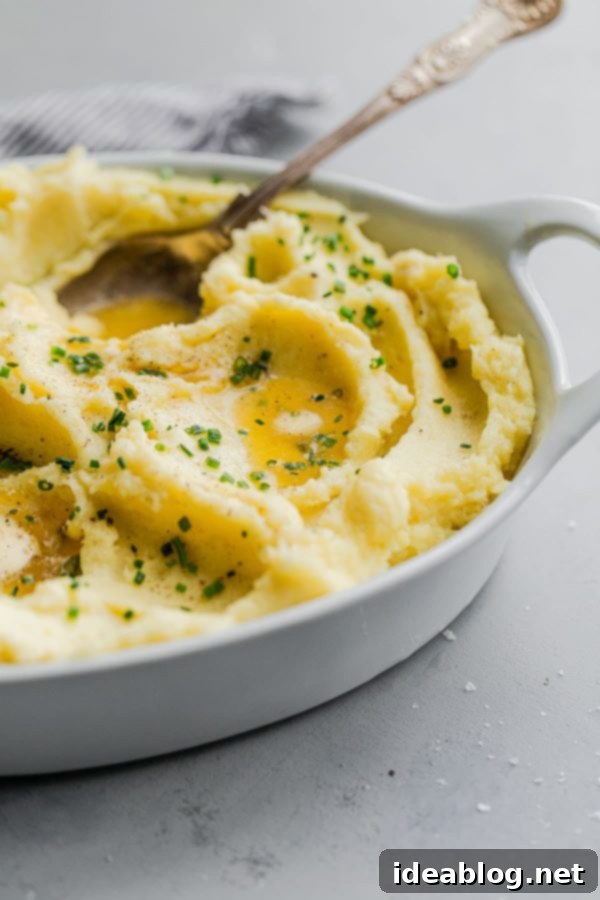
Mastering Make-Ahead: Preparing Mashed Potatoes in Advance
Mashed potatoes are wonderfully forgiving, making them one of the *easiest* side dishes to prepare in advance, a true blessing during busy holiday cooking schedules! This flexibility allows you to reduce stress on the day of your event, knowing a significant component of your meal is already taken care of.
How to Make Mashed Potatoes Ahead of Time:
These creamy Yukon Gold mashed potatoes can be prepared from start to finish up to 3 to 4 days before you plan to serve them. Once cooked and mashed, allow them to cool slightly, then transfer them to an airtight container or a large, heavy-duty Ziploc bag. For Ziploc bags, press out as much air as possible before sealing. Store the container or bag securely in the refrigerator until you are ready to reheat and serve. This method locks in freshness and flavor, ensuring your potatoes taste just as wonderful as if they were freshly made.
Expert Tips for Reheating Mashed Potatoes to Perfection
While freshly made mashed potatoes are always a delight, reheating them properly ensures they maintain their creamy texture and delicious flavor. Mashed potatoes can be held warm for several hours after cooking. However, if reheating directly from the refrigerator, keep in mind they are naturally dense and thick, which means they will take considerably longer to come back to temperature. Plan your timeline accordingly to avoid last-minute rushes, especially during holiday meals.
- Oven Method (for Casserole Style): This method is fantastic for large batches and creates a lovely top crust. Transfer the cold mashed potatoes to an oven-safe casserole dish. For extra richness and to prevent drying, dot the top generously with several pieces of unsalted butter. Lay a piece of parchment paper directly on the surface of the potatoes before covering the dish tightly with aluminum foil. Bake in a preheated 350°F (175°C) oven until thoroughly heated through, typically 25-40 minutes depending on the quantity and depth of the dish. Before serving, if desired, fold in a small splash of warm heavy cream or whole milk to restore any lost moisture and ensure maximum creaminess.
- Microwave Method (Quick & Easy): If you’re short on oven space or time, the microwave is an incredibly efficient and simple way to reheat mashed potatoes. Truthfully, this is a method I often turn to because it impacts the potatoes minimally, allowing them to retain their wonderful texture. Transfer the mashed potatoes to a microwave-safe serving dish. Microwave in 1 to 2-minute intervals, stirring gently between each interval, until the potatoes are heated evenly throughout. When using this method, I highly recommend stirring in a splash of warm heavy cream or whole milk just before serving. This will replenish any moisture lost during reheating and ensure your potatoes are as luscious as when they were first made.
- Sous Vide Method (Restaurant Quality): For the most consistent and gentle reheating, the sous vide method is unparalleled. Place your cold or freshly cooked mashed potatoes into a food-safe sous vide pouch. Seal the pouch, removing as much air as possible. Set your sous vide circulator to 150°F (65°C) and immerse the pouch. Cook until the potatoes are heated through, typically 45 minutes to an hour for cold potatoes, or simply hold them warm for several hours without any loss of quality. This technique ensures a perfectly even temperature throughout and maintains the potatoes’ original creamy texture.
- Stove Top Method (Classic & Controlled): This is an excellent method for smaller to medium batches. In a large saucepan, heat about 1 cup (240 mL) of whole milk (or heavy cream for extra richness) over medium-low heat until it just begins to simmer. Reduce the heat to low, then add the cold mashed potatoes to the saucepan. Stir them gently into the warm milk, breaking up any clumps, and continue to cook, stirring occasionally, until they are thoroughly heated through and regain their creamy consistency. If the potatoes appear too thick, add additional warm milk or cream a tablespoon at a time until the desired texture is achieved. Always taste and re-season with salt and pepper before serving, as flavors can sometimes mellow upon reheating.
- Slow Cooker Method (Ideal for Holding Warm): While I haven’t personally tested this specific method with this exact recipe, many home cooks have great success with it, particularly for holding mashed potatoes warm for extended periods. Transfer just-cooked warm mashed potatoes directly to your slow cooker or crockpot. Set the slow cooker to its lowest heat setting (usually “Warm” or “Low”) and stir occasionally. This method is fantastic for keeping your potatoes perfectly warm and ready to serve for several hours, making it perfect for buffets or extended family meals. Just be sure to stir in a splash of warm milk or cream periodically to maintain moisture and prevent the potatoes from drying out around the edges.
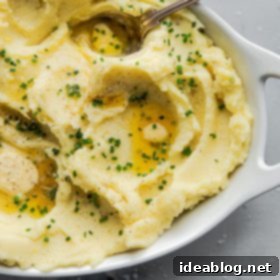
Classic Yukon Gold Mashed Potatoes
Pin
Review
Save
Saved!
6
– 8 Generous Servings
15
minutes
25
minutes
40
minutes
Equipment
-
OXO Good Grips Potato Ricer (recommended for ultimate creaminess)
-
OXO Good Grips Potato Masher (for traditional mashing)
-
Large Pot
-
Small Saucepan
Ingredients
For the Ultra-Creamy Yukon Gold Mashed Potatoes:
-
3½
lbs (1.6 kg)
Yukon Gold potatoes
, peeled and quartered for even cooking -
Kosher salt
, for seasoning the cooking water and to taste -
¾
cup (180 mL)
heavy cream
, warmed gently -
6
tablespoons (85 g)
unsalted butter or cultured butter
, divided; plus more for serving and dotting the top -
¼
cup (2 oz; 60 g)
creme fraiche or sour cream
, optional, for a tangy variation -
Freshly ground black pepper
, to taste
For Garnishing:
-
Fresh chives
, finely sliced, for a pop of color and fresh flavor
Instructions
-
1. Prepare the Potatoes: Peel the Yukon Gold potatoes and cut them into quarters. The goal is to keep the potato pieces as uniform in size as possible to ensure even cooking. If using particularly large Yukon Gold potatoes, quartering them will aid in faster cooking. Smaller or varied sizes may only need to be cut in half. Transfer the prepared potatoes to a large pot and cover generously with cold, salted water. Starting with cold water allows the potatoes to cook evenly from the inside out.
-
2. Cook to Perfection: Cover the pot and bring the water to a full boil over high heat. Once boiling, reduce the heat to a steady simmer. Continue simmering the potatoes until they are very tender and can be easily pierced with a knife or fork, practically slipping off the blade. If you encounter any resistance, continue cooking and check back in a few minutes.
-
3. Warm the Dairy: Meanwhile, in a small saucepan, combine the heavy cream and unsalted butter. Place the saucepan over very low heat until the butter has completely melted and the mixture is thoroughly warm. This step is crucial as heating the cream and butter helps them be absorbed more readily by the mashed potatoes, resulting in a silkier texture and keeping your potatoes hot for serving.
-
4. Mash the Potatoes: Carefully drain the cooked potatoes. (Pro Tip: You can warm your serving dish simultaneously by placing it directly underneath your colander, allowing the hot cooking water to heat it thoroughly. Just remember to dry it well before using!). For the ultimate fluffy texture, rice the drained potatoes in batches directly into the empty, warm cooking pot. If using a traditional masher: transfer the drained potatoes to the pot, add the warm cream and butter, and mash thoroughly until mostly smooth.
-
5. Combine and Season: Pour the warm cream and butter mixture over the riced (or mashed) potatoes. If using, add the creme fraiche or sour cream now. Add a generous pinch of kosher salt and freshly ground black pepper. Using a large spoon or spatula, fold all ingredients together gently without overmixing to avoid activating the starches, which can result in gluey potatoes. If you prefer a looser texture, add an additional splash of warm heavy cream or whole milk. Season the potatoes to taste with additional salt and pepper as needed. If preparing these mashed potatoes in advance, refer to the detailed reheating instructions in the notes section below.
-
6. Serve Immediately: Transfer the finished mashed potatoes to a warmed serving dish. Use the back of a large spoon to smooth the surface and create appealing swoops or peaks. Top with a few thin slices of unsalted butter, allowing them to melt into the hot potatoes, and garnish generously with finely chopped fresh chives. Serve these ultra-creamy, buttery Yukon Gold mashed potatoes immediately and enjoy!
How to Prep and Reheat Mashed Potatoes:
- These potatoes can be prepared start to finish up to 3 to 4 days prior to serving. Once cooled, transfer them to an airtight container (or a large Ziploc bag with the air squeezed out) and store in the refrigerator. Mashed potatoes can be held warm for several hours after cooking, but if reheating cold from the fridge, they will take longer to come to temperature due to their dense and thick nature. Keep this in mind when planning your timeline and choosing the reheating method below.
- Oven: Place the cold mashed potatoes in an oven-safe casserole dish. Dot the top with several pieces of unsalted butter and cover with a layer of parchment paper, then cover tightly with aluminum foil. Place in a preheated 350°F (175°C) oven and cook until heated through, typically 25-40 minutes. If desired, fold in a small splash of warm heavy cream before serving to restore moisture.
- Microwave: If oven space or time is limited, the microwave is a quick and effective way to reheat mashed potatoes. Transfer potatoes to a microwave-safe serving dish and microwave in 1 to 2-minute intervals, stirring gently between each one, until heated thoroughly. To compensate for any lost moisture, stir in a touch more warm heavy cream or whole milk just before serving.
- Sous Vide: For restaurant-quality reheating, place cold or just-cooked mashed potatoes in a sous vide pouch. Set your circulator to 150°F (65°C) and cook until heated through (approximately 45-60 minutes for cold potatoes, or hold warm for hours without overcooking).
- Stove Top: Heat 1 cup (240 mL) of whole milk (or heavy cream) in a large saucepan until it simmers. Lower the heat and add the cold mashed potatoes, stirring them into the milk until heated through and creamy. Add additional warm milk or cream if a looser texture is desired. Season to taste with salt and pepper.
- Slow Cooker: While not specifically tested with this recipe, many find success by transferring just-cooked warm mashed potatoes to a slow cooker or crockpot and holding them on the lowest “Warm” setting for several hours. Stir occasionally and add a splash of warm cream or milk if they begin to thicken.
Serving:
1
serving
,
Calories:
295
kcal
,
Carbohydrates:
34
g
,
Protein:
5
g
,
Fat:
16
g
,
Saturated Fat:
10
g
,
Polyunsaturated Fat:
5
g
,
Cholesterol:
47
mg
,
Sodium:
89
mg
,
Fiber:
4
g
,
Sugar:
3
g
Laura // A Beautiful Plate
Thanksgiving, Side Dish, Holiday Meal
American
Vegetarian
